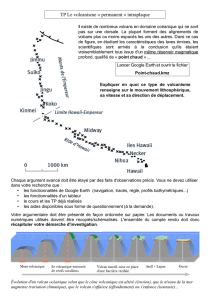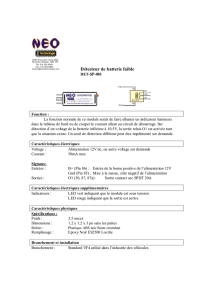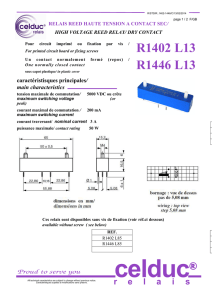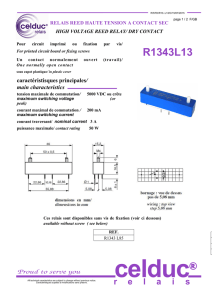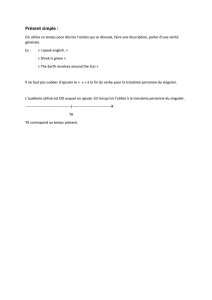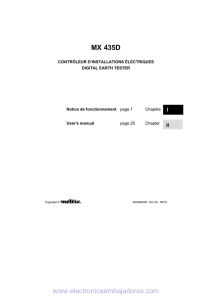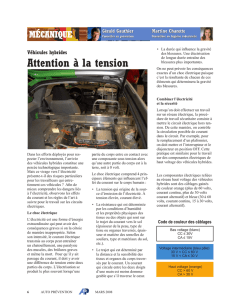MX 435D - Chauvin Arnoux
publicité
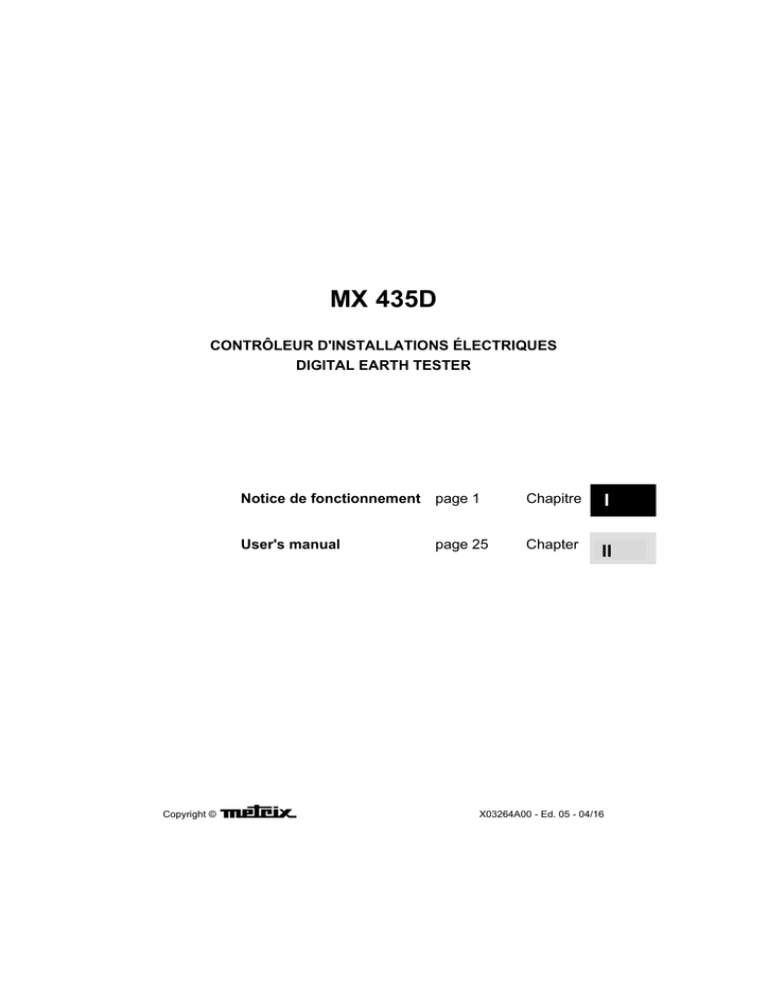
MX 435D
CONTRÔLEUR D'INSTALLATIONS ÉLECTRIQUES
DIGITAL EARTH TESTER
Copyright ©
Notice de fonctionnement
page 1
Chapitre
I
User's manual
page 25
Chapter
II
X03264A00 - Ed. 05 - 04/16
FACE AVANT / FRONT PANEL
2
15
14
13
12 11
10
1
9
16
3
3
4
5
6
7
8
FACE ARRIÈRE / REAR PANEL
18
19
17
20
Contrôleur d'installations électriques
LEGENDE
1
2
3
4
5
6
Interrupteur Marche/Arrêt « O/I »
Afficheur LCD
Bornes mesure de terre E, S, H
Bornes tension/courant VAC / AAC / RCD
Bornes continuité :
%RUQHVG¶LVROHPHQW0:
11
12
13
14
15
16
7
8
9
10
Voyant de présence tension
Touche « TEST »
Commutateur 6 positions
Mesure de continuité 20 :
17
18
19
20
Mesure de terre/loop 20 :
Mesure de terre/loop 2000 :
0HVXUHG¶LVROHPHQW0:
Mesure de courant par pince (AAC)
Mesure de tension VAC / Test RCD
Indicateurs calibre 30, 100, 300, 500,
650 mA
9LVG¶DFFqVDXORJHPHQWSLOHV
Béquille escamotable
&RQQH[LRQSRXUODUHFKDUJHGHO¶DSSDUHLO
Indicateur de présence de tension ou
G¶pWDWGHFKDUJH
CAPTION
11
12
13
14
20 : earth/loop measurement
2000 : earth/loop measurement
200 M: insulation measurement
Current measurement by clamp (AAC)
5
6
ON/OFF switch « O/I »
LCD display
E, S, H earth measurement terminals
RCD / VAC / AAC voltage / current
terminals
:continuity terminals
M:insulation terminals
15
16
7
8
9
10
LED of voltage presence
Pushbutton « TEST »
6-way switch
20 : continuity measurement
17
18
19
20
VAC voltage measurement / RCD test
30, 100, 300, 500, 650 mA range
indicators
Screw to the battery casing
Stand
Connection to charge the instrument
Indicator of voltage presence or state of
charge
1
2
3
4
Contrôleur d'installations électriques
Chapitre I
TABLE DES MATIERES
1.
INSTRUCTIONS GENERALES ................................................................................................................. 1
1.1.
Précautions et mesures de sécurité ................................................................................................... 1
1.1.1.
Avant utilisation ........................................................................................................................... 1
1.1.2.
Pendant l'utilisation ..................................................................................................................... 1
1.1.3.
Symboles .................................................................................................................................... 2
1.1.4.
Consignes ................................................................................................................................... 2
1.2.
Garantie .............................................................................................................................................. 3
1.3.
Réparation et vérification métrologique .............................................................................................. 3
1.4.
Entretien.............................................................................................................................................. 3
2.
DESCRIPTION DE L'APPAREIL ............................................................................................................... 4
2.1.
Description générale ........................................................................................................................... 4
2.1.1.
Mise sous tension, hors tension, arrêt automatique ................................................................... 4
2.1.2.
Commutateur .............................................................................................................................. 4
2.1.3.
Touche « TEST » ........................................................................................................................ 4
2.1.4.
Voyant de présence de tension .................................................................................................. 4
2.1.5.
Voyants des calibres RCD .......................................................................................................... 5
2.1.6.
Buzzer ......................................................................................................................................... 5
2.1.7.
Afficheur numérique .................................................................................................................... 5
2.1.8.
Bornes d'entrée........................................................................................................................... 5
2.1.9.
Béquille ....................................................................................................................................... 5
2.1.10.
Bloc de raccordement au secteur et assemblage .................................................................. 5
2.1.11.
Bloc alimentation/secteur 12 V ............................................................................................... 5
2.2.
Alimentation ........................................................................................................................................ 6
2.2.1.
Alimentation par pack accumulateurs (rappel : modèle CA réf. HX0086) .................................. 6
2.2.2.
Alimentation par piles 9 V ........................................................................................................... 9
2.3.
Stockage ........................................................................................................................................... 11
3.
DESCRIPTION FONCTIONNELLE ......................................................................................................... 12
3.1.
Mesure de continuité « x))) » ............................................................................................................ 12
3.2.
Mesure de terre « R EARTH ».......................................................................................................... 13
3.3.
Mesure de résistance de boucle « R LOOP » .................................................................................. 14
3.4.
0HVXUHG¶LVROHPHQW© Ri » ................................................................................................................ 15
3.5.
Mesure de courant alternatif «
» ..................................................................................... 15
3.6.
Mesure de tension alternative « VAC » ............................................................................................ 16
3.7.
Test RCD .......................................................................................................................................... 16
3.7.1.
Méthode .................................................................................................................................... 16
3.7.2.
6LJQLILFDWLRQGXFOLJQRWHPHQWG¶XQGHVYR\DQWVGHFDOLEUH ....................................................... 17
4.
SPECIFICATIONS TECHNIQUES ........................................................................................................... 18
4.1.
Caractéristiques fonctionnelles ......................................................................................................... 18
4.1.1.
Continuité (CEI 61557-4, 1997) ................................................................................................ 18
4.1.2.
Terre (CEI 61557-5, 1997)........................................................................................................ 18
4.1.3.
R LOOP .................................................................................................................................... 18
4.1.4.
Isolement (CEI 61557-2, 1997) ................................................................................................19
4.1.5.
Courant
(avec la pince MN73) .......................................................................................... 19
4.1.6.
Tension
............................................................................................................................. 19
4.1.7.
Test RCD .................................................................................................................................. 19
4.1.8.
Conditions de référence............................................................................................................ 20
4.1.9.
Conditions climatiques .............................................................................................................. 21
4.1.10.
9DULDWLRQGDQVOHGRPDLQHQRPLQDOG¶XWLOLVDWLRQ ....................................................................... 21
5.
CARACTERISTIQUES ............................................................................................................................. 24
5.1.
Caractéristiques générales ............................................................................................................... 24
5.2.
Pour commander .............................................................................................................................. 24
Contrôleur d'installations électriques
Chapitre I
1.
INSTRUCTIONS GENERALES
Vous venez d'acquérir un contrôleur d'installations électriques multifonctions ; nous vous
remercions de votre confiance.
Cet appareil est conforme à la norme de sécurité NF EN 61010-1 Ed. 2 (2001), relative
aux instruments de mesures électroniques. Il permet de vérifier les installations conformes à la
norme IEC 61557.
Pour votre sécurité et un meilleur service de votre appareil, vous devez :
- lire attentivement cette notice de fonctionnement,
- UHVSHFWHUOHVSUpFDXWLRQVG¶HPSORLTXL\VRQWGpFULWHV
Le contenu de cette notice ne peut être reproduit sous quelque forme que ce soit sans
notre accord.
1.1.
Précautions et mesures de sécurité
1.1.1. Avant utilisation
Cet instrument a été conçu pour une utilisation en intérieur, dans un environnement de
degré de pollution 2, à une altitude inférieure à 2000 m, à une température comprise entre
0qC et 45qC, avec une humidité relative de 80 % jusqu'à 31qC.
Il est utilisable pour des mesures sur des ciUFXLWVGHFDWpJRULHG¶LQVWDOODWLRQ,,,SRXUGHV
tensions n'excédant jamais 300 V par rapport à la terre.
'pILQLWLRQGHVFDWpJRULHVG¶LQVWDOODWLRQ :
La catégorie de mesure I correspond aux mesurages réalisés sur des circuits
non reliés directement au réseau.
Exemple : circuits électroniques protégés
CAT II: La catégorie de mesure II correspond aux mesurages réalisés sur les circuits
directement EUDQFKpVjO¶LQVWDOODWLRQEDVVHWHQVLRQ
Exemple : alimentation d'appareils ménagers et d'outillage portable
CAT III: La catégorie de mesure III correspond aux mesurages réalisés dans
O¶LQVWDOODWLRQGXEkWLPHQW
Exemple : alimentation de machines ou appareils industriels.
CAT IV: La catégorie de mesure IV correspond aux mesurages réalisés à la source de
O¶LQVWDOODWLRQEDVVHWHQVLRQ
Exemple : arrivées d'énergie
CAT I:
Les cordons et accessoires de raccordement doivent être conçus pour une tension
assignée et une catégorie de surtension au moins égales à celles des circuits sur
lesquels sont effectuées les mesures.
La sécurité de tout système qui pourrait intégrer cet instrument relève de la responsabilité de
O¶DVVHPEOHXUGXV\VWqPH
9pULILH]OHERQpWDWGHO¶LQVWUXPHQWHWGHVHVFRUGRQVHWDFFHVVRLUHVDYDQWXWLOLVDWLRQ
1¶XWLOLVH]SDVO¶DSSDUHLOVLODWUDSSHDXGRVGHO¶LQVWUXPHQWHVWDEVHQWHRXGpWpULRUpH
1.1.2. Pendant l'utilisation
1¶XWLOLVH]SDVO¶DSSDUHLOHQGHKRUVGHVVSpFLILFDWLRQVHWSURWHFWLRQVGpFULWHVGDQVFHWWH
notice.
Arrêt automatique O¶DUUrWGHO¶DSSDUHLOHVWDXWRPDWLTXHVLDXFXQHDFWLRQQ¶HVWHIIHFWXée sur
O¶LQVWUXPHQWSHQGDQWPLQXWHVYRLUS
3RVLWLRQQH]O¶LQWHUUXSWHXUVXU© O » pour ne pas user le pack accumulateurs ou les piles.
Contrôleur d'installations électriques
1
Chapitre I
1¶HIIHFWXH]SDVGHPHVXUHGHUpVLVWDQFHG¶LVROHPHQWGHWHUUHGHFRQWLQXLWpVXUGHVFLUFXLWV
sous tension.
(QFDVG¶HUUHXUGHPDQLSXODWLRQFRQQH[LRQDFFLGHQWHOOHjXQHWHQVLRQH[WpULHXUHHQ
isolement, continuité, terre), des protections électriques se mettent en oeuvre (CTP). Il
faudra attendre leur refroidissement (| 3 minutes) pour commencer de nouvelles mesures.
(QPRGH5&'XQQRPEUHpOHYpGHPHVXUHVVXFFHVVLYHVSHXWHQWUDvQHUO¶DUUrWPRPHQWDQp
de tout nouveau test pDUSURWHFWLRQWKHUPLTXH/¶XWLOLVDWHXUGHYUDDORUVDWWHQGUHXQ
refroidissement interne suffisant avant de relancer une série de mesures.
Si le symbole « BAT ªV¶DIILFKHLOIDXWLPSpUDWLYHPHQWUHFKDUJHUOHSDFNDFFXPXODWHXUs ou
changer les 2 piles.
1.1.3. Symboles
/HVV\PEROHVVXLYDQWVILJXUHQWVXUO¶LQVWUXPHQWHWVLJQLILHQW
ATTENTION : Risque de danger. Consultez la notice de fonctionnement.
Dans la présente notice de fonctionnement, les instructions
précédées de ce symbole, si elles ne sont pas bien respectées
ou réalisées, peuvent occasionner un accident corporel ou
HQGRPPDJHUO¶DSSDUHLOHWOHVLQVWDOODWLRQV
DANGER :
Risque de choc électrique.
Retrait des conducteurs non isolés non autorisé.
Borne de terre
Appareil entièrement protégé par isolation double ou isolation renforcée.
)
x ))
Signal sonore buzzer
Tri sélectif des déchets pour le recyclage des matériels électriques et
électroniques.
Conformément à la directive WEEE 2002/96/EC : ne doit pas être traité comme
déchet ménager.
Pince Accessoire
Conformité CE
Alimentation par pack accumulateurs 8,4V NiMH (modèle CA réf. HX0086
uniquement) ou par 2 piles type 9V.
Ce produit est recyclable à 100 %.
1.1.4. Consignes
Avant toute ouverture de l'appareil pour accéder au pack accumulateurs ou aux piles,
GpFRQQHFWH]OHVFRUGRQVGXFLUFXLWGHPHVXUHSXLVGHO¶DSSDUHLO
Tout réglage, entretien ou réparation du contrôleur ne doit être effectué que par un
personnel agréé par le constructeur.
En cas de défauts ou contraintes anormales, mettez l'appareil hors service et empêchez
son utilisation jusqu'à ce qu'il soit procédé à sa vérification.
Il est recommandé de retirer de l'instrument le pack accumulateurs ou les piles, en cas
de non utilisation prolongée.
2
Contrôleur d'installations électriques
Chapitre I
1.2.
Garantie
Ce matériel est garanti contre tout défaut de matière ou vice de fabrication, conforméPHQWDX[FRQGLWLRQVJpQpUDOHVGHYHQWH,OHVWDFFRPSDJQpG¶XQFHUWLILFDWGHYpULILFD-tion
délivré par nos laboratoires accrédités.
Durant la période de garantie (12 mois), l'appareil ne peut être réparé que par le
constructeur, celui-ci se réservant la décision de procéder soit à la réparation, soit à
l'échange de tout ou partie de l'appareil. En cas de retour du matériel au constructeur, le
transport aller est à la charge du client.
/DJDUDQWLHQHV¶DSSOLTXHSDVVXLWHj
1. une utilisation impropre du matériel ou par association de celui-ci avec un équipement
incompatible ;
2. une modification du matériel sans autorisation explicite des services techniques du
constructeur ;
3. O¶LQWHUYHQWLRQHIIHFWXpHSDUXQHSHUVRQQHQRQDJUppHSDUOHFRQVWUXFWHXU
4. l'adaptation à une application particulière, non prévue par la définition du matériel ou par
la notice de fonctionnement ;
5. un choc, une chute ou une inondation.
1.3.
Réparation et vérification métrologique
Comme tous les appareils de mesure ou d'essais, une vérification
périodique est nécessaire.
Pour les vérifications et étalonnage de vos appareils, adressez-vous à nos laboratoires de
métrologie accrédités COFRAC ou à votre centre technique régional Manumesure.
Renseignements et coordonnées sur demande : Tél. 02.31.64.51.55
Fax 02.31.64.51.09
Réparation sous garantie et hors garantie
Contactez votre agence commerciale Chauvin-Arnoux la plus proche ou votre centre
technique régional Manumesure qui établira un dossier de retour et vous communiquera la
procédure à suivre.
Coordonnées disponibles sur notre site : http://www.chauvin-arnoux.com ou par téléphone
aux numéros suivants : 02 31 64 51 55 (Centre technique Manumesure)
01 44 85 44 85 (Chauvin Arnoux).
1.4.
Entretien
x
x
x
Nettoyez l'instrument avec un chiffon humide et du savon.
N'utilisez jamais de produits abrasifs, ni de solvants.
Essuyez et laissez sécher parfaitement avant toute utilisation.
Contrôleur d'installations électriques
3
Chapitre I
2.
DESCRIPTION DE L'APPAREIL
2.1.
Description générale
Ce contrôleur d'installations électriques à affichage numérique, portable et alimenté par
un pack accumulateurs ou par piles 9 V, répond aux besoins des électriciens et des
organismes de contrôle.
Il est d'une utilisation sûre et simple et permet de réaliser les mesures essentielles d'une
installation électrique : mesures de résistance de terre et de boucle, d'isolement et de
continuité, de tension alternative, de courant alternatif et de courant de fuite, et test de
disjoncteur différentiel « RCD ».
2.1.1. Mise sous tension, hors tension, arrêt automatique
x En positionnant l'interrupteur sur « I », l'instrument est prêt à fonctionner. Choisissez
ensuite la fonction à l'aide du commutateur, branchez les cordons selon ce choix et, si
nécessaire, appuyez sur la touche (terre, isolement et RCD).
x Pour arrêter l'instrument, débranchez les cordons et mettez l'interrupteur en position « O ».
x /¶DUUrWGHO¶DSSDUHLOHVWDXWRPDWLTXHVLDXFXQHDFWLRQQ¶HVWHIIHFWXpHVXUO¶LQVWUXPHQW
pendant 10 minutes. Le défilement des 5 voyants des calibres RCD (repère 16) prévient
GHO¶DUUrWLPPLQHQWHWSHUPHWGHOHUHSRUWHUHQDFWLRQQDQWVXUODWRXFKH© TEST ».
x $SUqVO¶DUUrWDXWRPDWLTXHODUHPLVHHQPDUFKHGHO¶DSSDUHLOHVWREWHQXHHQSRVLWLRQQDQW
O¶interrupteur sur « O », puis sur « I ».
2.1.2. Commutateur
Un commutateur rotatif à 6 positions rend accessible les grandeurs mesurables :
x
x
x
x
x
x
continuité 20 : (avec bip sonore)
mesure de terre / loop 20 :
mesure de terre / loop 2000 :
PHVXUHG¶LVROHPHQW0:sous 500 VDC
mesure de courant par pince 2-200 AAC / 2 VAC sur entrée pince 2 VAC
mesure de tension 600 VAC HWPHVXUHGHWHPSVG¶RXYHUWXUHGHGLVMRQFWHXUGLIIpUHQWLHO
(test RCD).
2.1.3. Touche « TEST »
Cette touche :
x ODQFHODPHVXUHG¶LVROHPHQWHWODPHVXUHGHWHUUH,Oalimente le circuit spécifique et
DVVXUHXQHVpFXULWpHQWUHOHVERUQHVHWODKDXWHWHQVLRQGHO¶DSSDUHLOMaintenez la
WRXFKHHQIRQFpHMXVTX¶jVWDELOLVDWLRQFRPSOqWHGHO¶DIILFKDJH
Ne relâchez pas la touche « TEST »Æ Le résultat de la mesure est valide tant
que cette touche est maintenue enfoncée.
x lance le test RCD (voir §. 3.7, p. 16).
x SHUPHWOHUHSRUWGHO¶DUUrWDXWRPDWLTXH
2.1.4. Voyant de présence de tension
Un voyant indicateur (repère 7) signale la présence anormaOHG¶XQHWHQVLRQH[WpULHXUH$&
ou DC négative sur les bornes M:
4
Contrôleur d'installations électriques
Chapitre I
2.1.5. Voyants des calibres RCD
x /HGpILOHPHQWGHVYR\DQWVGHVFDOLEUHV5&'UHSqUHVLJQDOHTXHO¶DUUrW
automatique est imminent.
x En mesure RCD, un voyant allumé indique le calibre sélectionné pour effectuer le test
RXP$WDQGLVTX¶XQYR\DQWFOLJQRWDQWSUpFLVHODFDXVHGH
O¶LQWHUUXption du test (voir §. 3.7, p. 16).
2.1.6. Buzzer
En mode ohmmètre de continuité, le signal sonore du buzzer indique que la valeur de la
résistance mesurée est inférieure à 2 :.
2.1.7. Afficheur numérique
L'afficheur permet une lecture confortable des chiffres (hauteur 12,7 mm) de 3 ½ digits à
7 segments (2000 pts), avec ou sans virgule selon la gamme choisie (ex. 20.00 ou 2000).
2.1.8. Bornes d'entrée
/¶DSSDUHLOHVWpTXLSpGHERUQHVG
HQWUpH
x 1 borne COM / E / PE :
x
x
x
x
1 borne : :
1 borne VAC / AAC / RCD :
2 bornes M: :
2 bornes S et H :
entrée du point bas de la mesure commune aux
fonctions de voltmètre, ampèremètre,
test RCD, ohmmètre de continuité et de terre
continuité
tension, courant, RCD
isolement
mesure de terre
2.1.9. Béquille
/DEpTXLOOHHVFDPRWDEOHVLWXpHjO¶DUULqUHGHO¶DSSDUHLOSHUPHWHQXWLOLVDWLRQVXUWDEOH
G¶LQFOLQHUO¶DSSDUHLO
2.1.10. Bloc de raccordement au secteur et assemblage
Ce bloc vient s'enficher sur le bornier qu'il recouvre en totalité. Il permet le détrompage
phase/neutre et s'utilise en mesure RCD et R LOOP.
2.1.11. Bloc alimentation/secteur 12 V
Ce bloc permet la recharge du pack accumulateurs. La durpHGHFKDUJHHVWG¶HQYLURQK
Contrôleur d'installations électriques
5
Chapitre I
2.2.
Alimentation
L'alimentation de l'appareil est assurée :
x soit par un pack accumulateurs rechargeable, modèle CA réf. HX0086,
x soit par 2 piles alcalines.
2.2.1. Alimentation par pack accumulateurs (rappel : modèle CA réf. HX0086)
2.2.1.1. Généralités
Pack accumulateurs
Spécifications
8,4V Ni-MH - 750 mAh
Situation
/RJHPHQWDXGRVGHO¶DSSDUHLO(à la place des 2 piles 9 V)
Branchement
au connecteur, situé dans le logement
Recharge
Le symbole « BAT » s'affiche, si la tension est insuffisante. Il
faut alors procéder impérativement à la recharge du pack
accumulateurs (voir §. 2.2.1.3.).
$ILQG¶pYLWHUXQYLHLOOLVVHPHQWSUpPDWXUpGXSDFNDFFXPXODWHXUV
LOHVWUHFRPPDQGpG¶DWWHQGUHOHGpFKDUJHPHQWFRPSOHWDYDQWGH
recharger le pack accumulateurs.
Procédure
1. Déconnectez les cordons de test des circuits de mesure et
des entrées.
2. Positionnez l'interrupteur sur « O ».
2.2.1.2. Installation
Etape 1
Mettez en place la
barrette de raccordement
en commençant par la
droite.
6
Contrôleur d'installations électriques
Chapitre I
Etape 2
Branchez les
deux connecteurs
en prenant garde
de positionner les
fils loin de la vis
de fermeture et
de la LED de
signalisation.
Etape 3
Mettez en place le pack
accumulateurs en faisant
ressortir les fils à gauche
et connectez-le.
Etape 4 Refermez la trappe.
Contrôleur d'installations électriques
7
Chapitre I
2.2.1.3. Recharge du pack accumulateurs (rappel : modèle CA réf. HX0086)
Le symbole « BAT » s'affiche, si la tension est insuffisante. Il faut alors procéder
LPSpUDWLYHPHQWjODUHFKDUJHGXSDFNDFFXPXODWHXUVVDQVO¶H[WUDLUHGH son logement).
Etape 1
Connectez la prise
murale du boîtier
G¶DOLPHQWDWLRQDXVHFWHXU
HWOHMDFNjO¶LQVWUXPHQW
(boîtier inférieur).
Etape 2
Vérifiez le début de la
charge (LED jaune).Voir
commentaire ci-dessous.
Etape 3
Attendez le signal
lumineux de fin de
charge (LED rouge).
Si, au début de la charge, la LED jaune clignote, cela signifie que :
- soit la batterie est à un niveau très bas Æ il faut attendre une durée plus longue
avant que la charge ne soit complète ;
- soit la batterie est mal raccordée.
x /H0;'Q¶HVWSDVRSpUDWLRQQHOSHQGDQWODFKDUJHGXSDFNDFFXPXODWHXUV
x /HSDFNDFFXPXODWHXUVQHSHXWrWUHFKDUJpjO¶H[WpULHXUGHO¶LQVWUXPHQW
8
Contrôleur d'installations électriques
Chapitre I
2.2.2. Alimentation par piles 9 V
2.2.2.1.Généralités
Piles
Spécifications
2 piles alcalines 9 V, type 6LF22
Situation
/RJHPHQWDXGRVGHO¶DSSDUHLO
Branchement
en parallèle
Remplacement
Le symbole « BAT » s'affiche, si la tension des piles est
insuffisante. Il faut alors procéder impérativement au
changement des 2 piles.
Procédure
1. Déconnectez les cordons de test des circuits de mesure et
des entrées.
2. Positionnez l'interrupteur sur « O ».
3. Voir la mise place, ci-après
2.2.2.2.Installation
Etape 1
Démontez la trappe
jO¶DLGHG¶XQWRXUQHYLV
cruciforme.
Etape 2 Débranchez le pack accumulateurs et retirez-le.
Contrôleur d'installations électriques
9
Chapitre I
Etape 3
Débranchez les 2
connecteurs de la
barrette de
raccordement.
Etape 4
Retirez la barrette de
raccordement en
dégageant le coté
interne en premier,
comme ci-contre.
10
Contrôleur d'installations électriques
Chapitre I
Etape 5
Installez les piles dans
leur logement en
respectant les polarités.
2.3.
Stockage
Afin de garantir la précision des mesures, après une durée de stockage dans des
FRQGLWLRQVG¶HQYLURQQHPHQWH[WUrPHVDWWHQGH]OHWHPSVQpFHVVDLUHSRXUTXHO¶DSSDUHLO
revienne dans les conditions normales de mesure.
Contrôleur d'installations électriques
11
Chapitre I
3.
)
3.1.
DESCRIPTION FONCTIONNELLE
xLa tension maximale assignée des bornes est de 480 Veff.
x Pour toutes les fonctions, le dépassement de gamme est signalé par « I ».
xRappel :le défilement des 5 voyants des calibres RCD indique à l'utilisateur que
l'appareil s'éteindra dans une minute (sauf si la touche « TEST » est actionnée).
Mesure de continuité « x))) »
Une source génère un courant de 200 mA à travers la résistance à mesurer. La chute de
tension à VHVERUQHVSHUPHWG¶HQGpGXLUHVDYDOHXU
Les mesures ne doivent être faites que sur des installations - ou circuits - hors tension.
Méthode :
)
x Choisissez la position x)) avec le commutateur.
x Connectez les 2 cordons de mesure aux bornes COM et :.
Sur une installation, la borne COM sera, par exemple, reliée à la prise de terre du
bâtiment et la borne : servira à vérifier que les différents éléments conducteurs
accessibles (radiateurs, luminaires, tuyauteries, bornes de terre des prises murales,
etc. ...) sont bien reliées à cette prise de terre.
x La mesure de continuité est automatique, sans appui nécessaire sur « TEST ».
x La valeur de résistance est affichée en : et un bip sonore est émis si R < 2 :.
Si un « I » V¶DIILFKH la valeur de résistance est > 20 :
x (QSUpVHQFHG¶XQHWHQVLRQUpVHDXj+]SDUH[HPSOHOHELSHVWPRGXOp
Il faut absolument arrêter la mesure et supprimer la présence de la tension.
/¶DSSDUHLOHVWSURWpJpVDQVIXVLEOHMXVTX¶j9HII/HUHWRXUGHO¶DSSDUHLOHQ
condition normale se fera dans un délai de 30 s maximum.
Une permutation des cordons de mesure entre COM et :permet G¶LQYHUVHUODFLUFXODWLRQ
GHFRXUDQWHWDLQVLG¶REWHQLUpYHQWXHOOHPHQW :
R moy = R1 R2 , R1 et R2 étant mesurés avec des sens de circulation opposés.
2
La norme NFC 15-100 recommande que l'essai de continuité soit effectué avec une source
d'une tension à vide de 4 V à 24 V, en courant continu ou alternatif, et avec un courant d'au
moins 200 mA.
Le test est alors satisfaisant si la résistance mesurée ne dépasse pas 2 : garantissant
ainsi que toutes les masses métalliques sont bien reliées à la terre.
12
Contrôleur d'installations électriques
Chapitre I
3.2.
Mesure de terre « R EARTH »
Un générateur interne fait circuler, au travers de la terre à mesurer, un courant alternatif
entre les bornes H et E. La différence de potentiels créée et mesurée entre les bornes S et
E permet de définir la valeur de la résistance de la mise à la terre.
&RXSH]O¶DOLPHQWDWLRQGHO¶LQVWDOODWLRQHWRXYUH]ODbarrette de terre du bâtiment,
pour isoler la mise à la terre.
contrôleur
Barrette
de terre
S
E
H
Prise de
terre
0%
62 %
100 %
Méthode :
1. Choisissez, avec le commutateur, la position « R EARTH (
« R EARTH ( ) 20 : », pour affiner la mesure.
) 2000 : », puis
2. Reliez la borne E à la prise de terre à mesurer.
3. Enfoncez le plus complètement possible dans le sol le piquet H à une distance « d »
de la terre à mesurer (E).
*
&HWWHGLVWDQFHVHUDG¶DXWDQWSOXVJUDQGHTXHODSULVHGHWHUUHVHUDSURIRQGH
]RQHG¶LQIOXHQFHSOXVpWHQGXH
/¶H[SpULHQFHGHVPHVXUHVGHWHUUDLQDPRQWUpTX¶XQPLQLPXPGHPHQWUHOD
prise de terre E et le piquet H est souvent nécessaire, pour éviter la superposition
GHV]RQHVG¶LQIOXHQFHVHQWUDvQDQWGHVUpVXOWDWVHUURQpV
(QIRQFH]OHSLTXHW6GDQVO¶DOLJQHPHQWGHODSULVHGHWHUUH(HWGXSLTXHW+jXQH
distance de 62 % de « d ».
5. RDFFRUGH]OHVSLTXHWVjOHXUVERUQHVUHVSHFWLYHVVXUO¶DSSDUHLODXPR\HQGHV
cordons.
6. Appuyez sur la touche « TEST » jusqu'à stabilisation de la mesure.
Si le symbole « m ªDSSDUDvWHQKDXWjJDXFKHGHO¶pFUDQ/&'F¶HVWTXHOD
résistance du piquet auxiliaire de mesure « H » est supérieure à 5 k:.
On peut alors essayer de réduire cette résistance : déplacement du piquet sur un
terrain plus favorable, tassage et arrosage de la terre autour du piquet ...
Sinon, il convient de vérifier, sur les courbeVGXO¶LQIOXHQFHSRVVLEOHVXUOD
précision de mesure de cette forte résistance RH en fonction de la résistance à
mesurer Ra.
Contrôleur d'installations électriques
13
Chapitre I
Vérification de la mesure :
7. Notez la valeur mesurée précédemment.
8. A partir de la position initiale du piquet S, déplacez-le vers H puis vers E, sur une
distance égale à 10 % de « d ». Mesurez à chaque fois la résistance de terre et
notez les résultats.
9. Si les 3 valeurs sont identiques ou très proches, la mesure est correcte.
Sinon, augmentez la distance « d » et recommencez.
1¶RXEOLH]SDVGHUHFRQQHFWHUODEDUUHWWHGHWHUUHDSUqVODPHVXUH !
En cas de connexion accidentelle des bornes de mesure de terre à une tension AC,
O¶DSSDUHLOHVWSURWpJpMXVTX¶j9HII/HUHWRXUjXQIRQFWLRQQHPHnt normal se fera
en PRLQVG¶XQHminute.
Si « I ªV¶DIILFKHORUVG¶XQHPHVXUHVXUODFDOLEUH:, cela signifie que la résistance
terre est supérieure à 2000 :HWHVWGRQFFRQVLGpUpHFRPPHPDXYDLVHVLO¶LQVWDOODWLRQ
Q¶HVWSDVSURWpJpSDUXQGLVSRVLWLI à courant différentiel résiduel (DDR) de 30 mA.
En effet, comme indiqué dans la NFC 15-100, en schéma TT, la valeur de résistance de
WHUUHGRLWrWUHHQDGpTXDWLRQDYHFODVHQVLELOLWpGX''5SODFpHQWrWHGHO¶LQVWDOODWLRQWHO
que : ,ǻQ5WHUUH
Ainsi pour la valeur standard de DDR de 500mA, une prise de terre doit avoir une
résistance < 100 :SRXUSHUPHWWUHO¶pFRXOHPHQWGHVFRXUDQWVGHGpIDXW(cf. tableau
ci-dessous) :
3.3.
Mesure de résistance de boucle « R LOOP »
Cette mesure donne la valeur de ODUpVLVWDQFH513(&¶HVWXQPR\HQHIILFDFHGH
FRQWU{OHUODTXDOLWpG¶XQHSULVHGHWHUUHORUVTXHODPHVXUHGHWHUUHQ¶HVWSDVSRVVLEOH
(mesure par excès).
Méthode quel que soit le type de mesure choisi :
1. Choisissez, avec le commutateur, la position « R LOOP 2000 ȍ », puis
« R LOOP 20 ȍ », pour affiner la mesure.
2. 5DFFRUGH]OH0;'jXQHSULVHGHFRXUDQWDXPR\HQGHO¶DFFHVVRLUHSUpYXj
cet effet.
3. Appuyez sur la touche « TEST ».
4. Maintenez-ODHQIRQFpHMXVTX¶jVWDELOLVDWLRQFRPSOqWHGHO¶DIILFKDJH
Ne relâchez pas la touche « TEST »Æ Le résultat de la mesure est valide
tant que cette touche est maintenue enfoncée.
5. Si R < 20 ȍUHODQFH]ODPHVXUHVXUODSRVLWLRQ© R LOOP 20 ȍ » gamme pleine
échelle et appuyez à nouveau sur « TEST ».
14
Contrôleur d'installations électriques
Chapitre I
Une différence de potentiel N,PE excessive peut engendrer une erreur de mesure pour
VN,PE > 50 Veff.
Si « I » V¶DIILFKHHQ 2000 ȍ, la terre est mauvaise, car le piquet de terre doit avoir une
résistance <100 : SRXUSHUPHWWUHO¶pFRXOHPHQWGHVFRurants de défaut, selon NF C15-100.
3.4.
0HVXUHG¶LVROHPHQW© Ri »
La haute tension est générée aux bornes de la résistance à mesurer. La chute de tension
prélevée aux ERUQHVG¶XQHUpVLVWDQFHLQWHUQHFRQQXe en série avec la résistance à
PHVXUHUSHUPHWG¶HQGpGXLUHVDYDOHXU
Les essais ne doivent être effectués que sur des circuits hors tension.
Le voyant
« Risque de choc électrique » eQIDFHDYDQWGHO¶DSSDUHLOGRLW
absolument être éteint.
En cas de présence de la tension réseau avant la mesure, O¶DSSDUHLOHVWSURWpJpMXVTX
j
480 Veff. Le retour à une mesure normale se fera en 1 minute en environ.
Les résultats de mesure peuvent être faussés par les impédances de circuits additionnels
connectés en parallèle ou par des courants transitoires.
Méthode :
x Choisissez la position « Ri M: » avec le commutateur.
x Connectez les cordons de mesure aux bornes M: « + » et « - ªVXUO¶DSSDUHLO
x Reliez-les à la résistance à mesurer.
x Appuyez sur la touche « TEST » jusqu'à la stabilisation de la mesure.
Une tension G¶HQYLURQ 500 VDC est générée.
x La haute tension résiduelle présente sur le circuit testé se décharge via les cordons
GHPHVXUHGDQVO¶DSSDUHLOjWUDYHUVXQHUpVLVWDQFHGH0:. La mesure terminée,
LOIDXWGRQFODLVVHUO¶DSSDUHLOEUDQFKpTXHOTXHVVHFRQGHV
En cas de mesure par rapport à la terre, il est préférable de relier la borne « + » à la
terre.
6L©,ªV¶DIILFKHFHODFRUUHVSRQGjXQGpSDVVHPHQWGHJDPPH, ce qui signifie que la
mesure est supérieure à la limite haute, soit 200 M:.
La mesure est donc correcte, puisque la NFC 15-100 demande une mesure
d'isolement > 0,5 Mȍ pour une tension de test de 500 VDC injectée.
3.5.
Mesure de courant alternatif «
»
Il est possible de mesurer les courants et les courants de fuite avec ce contrôleur, en
utilisant une pince de courant uniquement.
/DSLQFH01SHUPHWG¶HIIHFWXHUGHVPHVXUHVVXUJDPPHV : 2 A et 200 A.
x Sur la gamme 2 A, la lecture est directe, en mA, avec une sensibilité de 1 digit/mA.
x Sur la gamme 200 A, la lecture se fait avec une sensibilité de 10 digits/A.
Le résultat affiché doit donc être divisé par 10 pour obtenir la valeur en A.
Contrôleur d'installations électriques
15
Chapitre I
/¶XWLOLVDWLRQGHFHWWHSLQFHSHUPHWVDQVDXFXQHFRXSXUHGHVFLUFXLWVF¶HVW-à-dire en toute
sécurité, de mesurer, par exemple, les courants de fuite dus à des SUREOqPHVG¶LVROHPHQW
dans une installation.
Méthode :
x
x
x
x
3.6.
Choisissez la position « pince » avec le commutateur.
Connectez la pince aux bornes COM et « pince ».
Choisissez le calibre adéquat sur la pince (2 A ou 200 A).
Enserrez le ou les câbles à contrôler. La mesure est automatique.
Mesure de tension alternative « VAC »
&HWWHIRQFWLRQHVWXWLOHSRXUOHFRQWU{OHG¶XQHLQVWDOODWLRQSUpDODEOHPHQWDX[FRQWU{OHVGH
FRQWLQXLWpGHWHUUHRXG¶LVROHPHQWSDUH[HPSOH
Méthode :
x Choisissez la position 600 V
avec le commutateur.
x Connectez les cordons de mesure aux bornes COM et V.
x La mesure de la tension en volt est automatique.
3.7.
Test RCD
/HWHVWV¶HIIHFWXHHQWUHODSKDVHHWODWHUUH,OHVWHQPRGHSXOVH[,'Q/¶XWLOLVDWHXU
sélectionQHO¶XQHGHVYDOHXUVGHFRXUDQWHQIRQFWLRQGXFDOLEUHGXGLVMRQFWHXUGLIIpUHQWLHO
à tester : 30 mA, 100 mA, 300 mA, 500 mA et 650 mA
Le résultat du test est le temps de disjonction exprimé en ms.
3.7.1. Méthode
x Placez l'interrupteur en position « I ».
x Choisissez la position RCD, avec le commutateur.
x 5DFFRUGH]OH0;'jODSULVHGXFRXUDQWDXPR\HQGHO¶DFFHVVRLUHSUpYXRX
reliez la borne PE au circuit de terre de protection et la borne L au circuit de phase,
dont on veut vérifier la protection.
Etape
16
Action
Fonction
1
Appui long (> 2 s)
sur « Test »
Sélection de la fonction RCD, calibre 30 mA.
Le voyant correspondant est allumé. L'afficheur
indique la tension (en V) présente aux bornes de
l'appareil. (I'n = 30 mA)
2
Appui bref (< 2 s)
sur « Test »
6pOHFWLRQG¶XQDXWUHFDOLEUHGHFRXUDQW
Chaque appui sélectionne en boucle le calibre suivant
avec allumage du voyant correspondant.
(I'n = 100 mA, I'n = 300 mA, I'n = 500 mA ou
I'n = 650 mA).
3
Appui long
sur « Test »
Lancement du test.
6¶Ll y a déclenchement Æ VDGXUpHV¶DIILFKHHQPV
/¶DIILFKDJHGH© I ªLQGLTXHO¶DEVHQFHGH
déclenchement durant 0,5 s (passage du courant I'n).
4
Appui court
sur « Test »
Sortie de la fonction. L'afficheur indique la tension
(en V) présente aux bornes de l'appareil.
Contrôleur d'installations électriques
Chapitre I
*
/DIRQFWLRQ5&'Q¶DXWRULVHTX¶XQVHXOWHVWSDUHQWUpHGDQVOHPRGH
Pour renouveler un test, il est nécessaire de clore le mode (étape 4)
SRXUO¶RXYULUjQRXYHDXpWDSH
/HIRQFWLRQQHPHQWG¶XQGLIIpUHQWLHOHVWFRUUHFWV¶LO déclence pour un courant inférieur au
courant nominal et dans un temps < 300 ms, selon NFC15-100.
3.7.2. 6LJQLILFDWLRQGXFOLJQRWHPHQWG¶XQGHVYR\DQWVGHFDOLEUH
/HWHVW5&'QHV¶HVWSDVHIIHFWXpGHIDoRQQRUPDOHO¶DSSDUHLODIILFKH© I » ou « 000 » et
O¶XQGHVWURLVYR\DQWVGHFDOLEUHFOLJQRWH :
celui du calibre 30 mA
Æ hors plage de tension
Tension trop grande ou absente.
celui du calibre 100 mA
Æ hors plage de fréquence
La fréquence de la tension présente
Q¶HVWSDVFHOOHG¶XQUpVHDXRXUpVHDX
trop pollué.
celui du calibre 300 mA
Æ hors plage de température
7HPSpUDWXUHGDQVO¶DSSDUHLOWURS
pOHYpH/DLVVH]UHIURLGLUO¶DSSDUHLODYDQW
de procéder à de nouveaux tests.
Contrôleur d'installations électriques
17
Chapitre I
4.
4.1.
SPECIFICATIONS TECHNIQUES
Caractéristiques fonctionnelles
(Précision = n % L + n UR signifie « n % de la lecture + n Unité de Représentation »
selon CEI 485).
4.1.1. Continuité (CEI 61557-4, 1997)
Gamme
Résolution
Précision
Courant de mesure
Tension à vide
Protection
Seuil buzzer
0,10 - 20,00 :
0,01 :
de 0,10 : à 0,12 :
de 0,13 : à 0,19 :
de 0,20 : à 20,0 :
> 200 mADC
4 V d V d 24 VDC
480 Veff
2 : ± 0,15 :
:
:
:
2%
2%
± 3 UR
± 4 UR
± 5 UR
8QHSHUPXWDWLRQGHVFRUGRQVGHPHVXUHSHUPHWWUDG¶LQYHUVHUODFLUFXODWLRQGH
FRXUDQWHWDLQVLG¶REWHQLUpYHQWXHOOHPHQW5PR\ R1 R2 , R1 et R2 étant mesurés
2
avec des sens de circulation opposés.
4.1.2. Terre (CEI 61557-5, 1997)
Gamme
Résolution
Précision
0,15 - 20,00 :
15 - 2000 :
0,01 :
1:
de 0,15 : à 0,20 : : 2 % ± 4 UR de 15 : à 50 : : 2 % ± 4 UR
de 0,21 : à 0,50 : : 2 % ± 5 UR de 50 : à 2000 : : 2 % ± 5 UR
de 0,51 : à 20 : : 2 % ± 8 UR
< 5 mA
Courant sortie max. < 5 mA
< 25 V
< 25 V
Tension à vide
Fréquence de UTEST 1024 Hz
480 Veff
Protection
1024 Hz
480 Veff
4.1.3. R LOOP
Gamme
Résolution
Précision
Courant sortie max.
Tension à vide
Fréquence de UTEST
Protection
18
0,00 - 20,00 ȍ
0 - ȍ
0,01 ȍ
1ȍ
± 2,0 % ± 8 UR
± 2,0 % ± 5 UR
< 5 mA
< 5 mA
< 25 V
< 25 V
1024 Hz
1024 Hz
480 Veff
480 Veff
Contrôleur d'installations électriques
Chapitre I
4.1.4. Isolement (CEI 61557-2, 1997)
Gamme
Résolution
Précision
0,1 ... 0,5 ... 200,0 M:
:
100 k:
de 0,1 M: à 0,5 M:
: de 0,5 M: à 0,6 M:
: de 0,7 M: à 0,8 M:
: 3%
de 0,9 M: à 10,0 M: : 3 %
de 10,1 M: à 200 M: : 3 %
Courant de mesure t 1,0 mADC pour R d 500 k:
Courant en CC max. d 4,0 mADC
500 VDC
Tension nominale
500 V d V d 550 VDC
Tension à vide
480 Veff
Protection
4.1.5. Courant
± 1,5 UR (hors CEI 61557)
± 1,5 UR
± 2,0 UR
± 2,5 UR
± 3,0 UR
(avec la pince MN73)
avec la pince MN73
Entrée tension du
contrôleur seul
Calibre
0 à 200 A
0 à 2000 mA
0 à 2000 mV
Résolution
100 mA
1 mA
1 mV
Précision
± 2 () % ± 7 UR
± 1 () % ± 7 UR
± 1 % ± 5 UR
1 M:
1 M:
480 Veff
480 Veff
Résistance entrée 1 M:
Protection
480 Veff
() typique
La composante DC est coupée en entrée du contrôleur par un condensateur.
4.1.6. Tension
Calibre
0 - 600 V
Résolution
1V
Précision
± 1,5 % ± 5 UR
,PSpGDQFHG¶HQWUpH
1 M:
Protection
> 480 Veff
La composante DC est coupée en entrée du contrôleur par un condensateur.
4.1.7. Test RCD
4.1.7.1. 'RPDLQHG¶XWLOLVDWLRQ
7HQVLRQGHO¶LQVWDOODWLRQ
190 à 290 V
Fréquence
45 à 65 Hz
Température interne max.
80qC
Contrôleur d'installations électriques
19
Chapitre I
4.1.7.2. Caractéristiques de génération
Nature du test
Test de disjonction
Courants de test I'
'n en mA
30, 100, 300, 500, 650
Précision du courant de test «P$
Durée max. G¶DSSOLFDWLRQ
500 ms
4.1.7.3. Caractéristiques des mesures de temps de disjonction
TestN
0RGHG¶LPSXOVLRQ
*DPPHG¶DIILFKDJH
0 - 500 ms
Domaine de
fonctionnement
5 - 500 ms
Domaine de mesure
spécifié
5 - 500 ms
Résolution
1 ms
Précision
2 ms
4.1.7.4. Fusible
/HIXVLEOHQHSHXWHQDXFXQFDVrWUHUHPSODFpSDUO¶XWLOLVDWHXU9HXLOOH]FRQWDFWHUO¶XQHGHV
agences régionales Manumesure agréées.
4.1.8. Conditions de référence
Température
Humidité
7HQVLRQG¶DOLPHQWDWLRQDYHFSLOHV
23qC ± 3 K
45 à 60 % HR
7HQVLRQG¶DOLPHQWDWLRQDYHFSDFNDFFX&$
8,4 V
45 à 65 Hz
Fréquence de la tension mesurée
Fréquence du courant mesuré
Capacité en parallèle sur la résistance
Champ électrique
Champ magnétique
Résistances de piquet
Tension parasite
20
8,5 V
45 à 65 Hz
nulle
nul
< 40 A/m
nulles
nulle
Contrôleur d'installations électriques
Chapitre I
4.1.9. Conditions climatiques
Domaines de :
référence
utilisation
stockage
4.1.10. 9DULDWLRQGDQVOHGRPDLQHQRPLQDOG¶XWLOLVDWLRQ
*UDQGHXUVG¶LQIOXHQFH
RCD
autres
fonctions
RCD
Humidité
autres
fonctions
RCD
Tension
autres
alimentation
fonctions
Fréquence en ampère
Fréquence en volts
Capacité // sur la
UpVLVWDQFHG¶LVROHPHQW
Influence de résistance
de piquet (dans S et H)
Gamme 20 :
Gamme 2000 :
Influence de tension
parasite selon
CEI 61557-5 à 3 V, en Hz
Température
Contrôleur d'installations électriques
Limites du domaine
G¶XWLOLVDWLRQ
0 à 45qC
Variation de la mesure
typique
maximale
1 % / 10qC ± 1 UR
2 % / 10qC ± 2 UR
0,4 % / 10qC
0,5 % / 10qC
2 % ± 2 UR
20 à 80 % HR
0,5 %
1 % / V ± 1 UR
7 V à 10 V
0 UR
1 UR
45 à 65 Hz
45 à 65 Hz
1 UR
1 UR
2 UR
2 UR
0 à 5 µF
0 UR
1 UR
0 à 100 x Ra
(< 50 k:)
0%
9%
15 %
16,66 ; 50 ; 60 ; 400
0 UR
0 UR
-
21
Chapitre I
MESURE DE TERRE - INFLUENCE TYPIQUE DE RÉSISTANCE DES PIQUETS
Gamme 20 Ohms
Erreur de mesure (%)
25
20
15
Ra = 0.3 Ohm
Ra = 10 Ohms
10
5
0
0
2
4
6
8
10
12
14
kOhms
Gamme 2000 Ohms
25
Erreur de mesure (%)
20
15
Ra = 30 Ohms
Ra = 1000 Ohms
10
5
0
0
10
20
30
40
50
60
-5
kOhms
22
Contrôleur d'installations électriques
Chapitre I
,1)/8(1&(7<3,48('¶81(7(16,213$5$6,7('(/$0(685('(7(55(
Gamme 20 Ohms
Erreur de mesure (%)
1
0.9
0.8
0.7
0.6
Ra = 1 Ohm
0.5
Ra = 10 Ohms
0.4
0.3
0.2
0.1
0
0
5
10
15
20
Tension parasite (V) de 16 2/3 Hz à 60 Hz
Gamme 2000 Ohms
8
Erreur de mesure ( %)
7
6
5
Ra = 10 Ohms
4
Ra = 100 Ohms
3
2
1
0
0
5
10
Tension parasite (V) de 16
Contrôleur d'installations électriques
15
20
2/3 Hz à 60 Hz
23
Chapitre I
5.
CARACTERISTIQUES
5.1.
Caractéristiques générales
Sécurité électrique
NF EN 61010-1, Ed. 2, 2001
classe 2, catégorie III pour 300 V par rapport à la terre,
degré de pollution 2
CEM
NF EN 61326-1 : 2006
Emission : classe B
Immunité : niveau résidentiel
Alimentation
Pack accumulateurs CA
8,4V NiMH - 750 mAh
en mesures de 5 s
2 piles 9V alcalines 6LF22
(DURACELL modèle MN1604)
en mesures de 5 s
| 900
! 5000
| 900
! 7700
! 7700
| 1800
| 1000
! 5500
| 1000
! 8500
! 8500
| 2000
Autonomie
Continuité
Terre / Loop
Isolement
Courant (pince)
Tension
Test RCD
Indice de protection
Dimensions, masse
5.2.
IP 40
195 x 97 x 55 mm, 670 g
Pour commander
&RQWU{OHXUG¶LQVWDOODWLRQVpOHFWULTXHVPXOWLIRQFWLRQV ...............................................................MX0435D
24
x
Livré avec :
x
Accessoires :
Kit de terre basique (15 m) ............................................................................................ P01102019
Kit Terre 3 pôles (50 m) ................................................................................................. P01102021
Sac souple, comprenant :
2 piquets droits
1 maillet
5 adaptateurs cosse fourche / banane 4 mm
1 bobine de 50 m de câble rouge
1 bobine de 50 m de câble bleu
1 enrouleur de 10 m de câble vert
Kit terre 3 pôles (100 m) ............................................................................................... P01102022
Kit terre 3 pôles (150 m) ............................................................................................... P01102023
Pince ampèremétrique MN73 200 AAC / 2 AAC............................................................... P01120421
x
Rechange :
Sacoche de transport / utilisation du contrôleur ............................................................. HX0089
2 cordons de sécurité coudé-droit (rouge + noir) de 1,50 m .......................................... P01295289Z
Pile 9V alcaline .............................................................................................................. P01100620
Pile 9V alcaline (x 12) ................................................................................................... P01100620A
Pile 9V alcaline (x 24) ................................................................................................... P01100620B
Pince crocodile (rouge + noire)...................................................................................... P01102052Z
Pointe de touche (rouge + noire) ................................................................................... P01102051Z
1 piquet terre T .............................................................................................................. P01102031
Pack accumulateurs ...................................................................................................... HX0086
Prise murale 12 V .......................................................................................................... HX0088
Sac de transport standard ............................................................................................. P01298066
Sac de transport prestige .............................................................................................. P01298067
Bloc de raccordement.................................................................................................... HX0087
Sacoche de transport / utilisation du contrôleur
2 cordons de sécurité coudé-droit (rouge + noir) de 1,5 m
2 pointes de touche (rouge + noire)
2 pinces crocodile (rouge + noire)
1 pack accumulateurs
1 prise murale 12 V
1 bloc de raccordement
Notice de fonctionnement en 2 langues
Contrôleur d'installations électriques
Chapter II
USER MANUAL
CONTENTS
1.
GENERAL INSTRUCTIONS .......................................................................................................... 26
1.1. Precautions and safety measures ........................................................................................... 26
1.1.1. Before using the tester...................................................................................................... 26
1.1.2. Using the tester................................................................................................................. 26
1.1.3. Symbols ............................................................................................................................ 27
1.1.4. Instructions ....................................................................................................................... 27
1.2. Warranty .................................................................................................................................. 28
1.3. Repair and metrological verification ........................................................................................ 28
1.4. Cleaning .................................................................................................................................. 28
2.
DESCRIPTION OF THE INSTRUMENT ......................................................................................... 29
2.1. General description ................................................................................................................. 29
2.1.1. Powering up, powering down and auto-shutoff ................................................................. 29
2.1.2. Selector switch.................................................................................................................. 29
2.1.3. "TEST" pushbutton ........................................................................................................... 29
2.1.4. Voltage presence lamp ..................................................................................................... 29
2.1.5. RCD range lights .............................................................................................................. 30
2.1.6. Buzzer .............................................................................................................................. 30
2.1.7. Digital display.................................................................................................................... 30
2.1.8. Input terminals .................................................................................................................. 30
2.1.9. Stand ................................................................................................................................ 30
2.1.10. Mains connector unit and assembly .................................................................................... 30
2.1.11. 12 V mains power supply .................................................................................................... 30
2.2. Power supply ........................................................................................................................... 31
2.2.1. Supply via an accumulator pack (reminder: CA model ref. HX0086) .................................... 31
2.2.2. V battery supply ................................................................................................................... 34
2.3. Storage .................................................................................................................................... 36
3.
FUNCTION DESCRIPTION ............................................................................................................ 37
3.1. &RQWLQXLW\PHDVXUHPHQWV³x´ ............................................................................................... 37
3.2. R Earth measurements............................................................................................................ 38
3.3. Measuring the "R loop" resistance........................................................................................... 39
3.4. Ri Insulation Measurements .................................................................................................... 40
3.6. Measuring AC voltage ............................................................................................................. 41
3.7. RCD test .................................................................................................................................. 41
3.7.1. Method .................................................................................................................................. 41
3.7.2. Meaning of one of the range lights flashing .......................................................................... 42
4. Technical specifications .................................................................................................................. 43
4.1. Functional specifications ......................................................................................................... 43
4.1.1. Continuity (IEC 61557-4, 1997) ........................................................................................ 43
4.1.2. Earth (IEC 61557-5, 1997) ................................................................................................ 43
4.1.3. R LOOP ............................................................................................................................ 43
4.1.4. Isolation (IEC 61557-2, 1997) ........................................................................................... 44
4.1.5. Current (with MN73 clamp) ............................................................................................... 44
4.1.6. Voltage
....................................................................................................................... 44
4.1.7. RCD test ........................................................................................................................... 44
4.1.8. Reference conditions ........................................................................................................ 45
4.1.9. Climatic conditions ............................................................................................................ 46
4.1.10. Variation in nominal field of use ........................................................................................ 46
5.
SPECIFICATIONS .......................................................................................................................... 49
5.1. General specifications ............................................................................................................. 49
5.2. To order ................................................................................................................................... 49
Digital Earth Tester
25
Chapter II
1.
GENERAL INSTRUCTIONS
Thank you for purchasing this multi-function digital earth tester.
This instrument complies with safety norm EN 61010-1 Ed. 2 (2001) applicable to electronic
measuring instruments. It allows operators to check that installations comply with IEC
61557.
For your safety and to get the most from your instrument, please:
Read these operating instructions carefully,
Follow the written user instructions
x
x
The contents of this manual may not be reproduced in any form without our consent.
1.1.
Precautions and safety measures
1.1.1. Before using the tester
This instrument is designed for use indoors, within a pollution level 2 environment, at an
altitude of less than 2000 m, at a temperature of between 0qC and 45qC, with 80 %
relative humidity up to 31qC.
It can be used for testing category III installations, with voltages that do not exceed
300 V in relation to the earth.
Definition of installation categories :
x
CAT IV:
x
CAT III:
x
CAT II:
x
CAT I:
Measurement category IV corresponds to measurements taken at the source of
low-voltage installations.
Example: power feeders
Measurement category III corresponds to measurements on building
installations.
Example: industrial machinery or instrument power supplies
Measurement category II corresponds to measurements taken on circuits
directly connected to low-voltage installations.
Example: household appliance and portable tool power supplies
Measurement category I corresponds to measurements taken on circuits not
directly connected to the network.
Example: protected electronic circuits
The leads and connection accessories used must be designed for a specific voltage and
an over-voltage category equivalent at least to that of the circuits on which the
measurements are carried out.
The safety of any system incorporating this instrument is the responsibility of the system
assembler.
Check the condition of the instrument, leads and connection accessories before
use. Do not use the device if the battery compartment is missing or damaged.
1.1.2. Using the tester
Never use the instrument outside the specifications and protection levels described in
this manual.
Automatic shutdown: the device will shut down automatically if the instrument is not used
for 10 minutes (see paragraph 2.1.1, p. 29).
Turn the switch to "O" to avoid discharging the accumulator pack or the batteries.
26
Digital Earth Tester
Chapter II
Do not perform earth, continuity or insulation resistance measurements on live circuits.
In the event of incorrect handling (accidental connection to an external voltage during
insulation, continuity or earth measurements), electrical protection systems are activated
(CTP). You must wait for them to cool down (| 3 minutes) before performing more
measurements.
In RCD mode, a high number of successive measurements may cause any new test
using thermal protection to stop momentarily. Users should then wait for sufficient
internal cooling before starting a new series of measurements.
,IWKHV\PERO³%$7´LVGLVSOD\HGLWLVLPSHUDWLYHWRUHORDGWKH accumulator pack or to
change the batteries.
1.1.3. Symbols
The following symbols, represented on the front panel, have the following meanings:
WARNING
DANGER
Risk of DANGER ! 5HIHUWRWKHXVHU¶VPDQXDO
Failure to perform the instructions in this operating manual
preceded by this symbol, or to perform them correctly, may cause
bodily injury or damage to the instrument and the installations.
Risk of electrical shock
Withdrawal authorized on conductors containing dangerous
voltages.
Earth
Equipment protected throughout by double or reinforced insulation.
)
x ))
Buzzer
The rubbish bin with a line through it means that in the European Union, the
product must undergo selective disposal for the recycling of electric and electronic
material, in compliance with Directive WEEE 2002/96/EC.
Clamp
Conform to CE standard
Power supplied by an accumulator pack - 8.4V NiMH (CA model ref. HX0086 only)
or by two 9V batteries
This product is 100% recyclable.
1.1.4. Instructions
Before opening the device to access accumulator pack or the batteries, disconnect the
measuring circuit leads, then the device.
Adjustments, maintenance or repair work on the tester must only be carried out by
qualified personnel approved by the manufacturer.
In the event of faults or abnormal constraints, power down the instrument and do not
allow anyone to use it until it has been checked.
It is advisable to remove the accumulator pack or the batteries if the instrument is not
going to be used for a long time.
Digital Earth Tester
27
Chapter II
1.2.
Warranty
This equipment is guaranteed against material faults or defective manufacture, in
compliance with the general sales conditions. It is supplied with a verification certificate
issued by our authorised laboratories.
During the warranty period (12 months), the instrument may only be repaired by the
manufacturer, who reserves the right to repair the instrument or to exchange all or part of
it. If the equipment is returned to the manufacturer, the outgoing transport costs are
borne by the customer.
The warranty is not applicable in the following cases:
1. improper use of the equipment or use of it in conjunction with incompatible equipment;
2. modifications to the equipment without the explicit authorisation of the manufacturer's
technical department;
3. work carried out on the instrument by a person not approved by the manufacturer;
4. adaptation for a specific application, not included in the definition of the equipment or the
user's manual;
5. shock, fall or water damage.
1.3.
Repair and metrological verification
A periodic verification is necessary, as for all measurement or test
instruments.
To have your instruments checked and calibrated, please consult our COFRAC approved
laboratories.
Repairs
For all repairs under guarantee or outside guarantee, please return the device to your
distributor.
1.4.
Cleaning
Clean the instrument with a damp cloth and soap. Never use abrasive products or solvents.
Wipe and leave to dry completely before using.
28
Digital Earth Tester
Chapter II
2.
DESCRIPTION OF THE INSTRUMENT
2.1.
General description
This portable, accumulator pack (or 9V-battery) powered, digital earth tester is fully-featured
to meet the needs of electricians and inspection authorities.
With this safe and easy-to-use instrument, you can carry out all the essential measurements
on an electrical installation: resistance measurements on earth and R Loop, insulation and
continuity, AC voltage, AC current, leak current and RCD differential circuit breaker.
2.1.1. Powering up, powering down and auto-shutoff
x Turn the switch to "I" and the instrument is ready to be used. Then choose the
required function using the selector switch, plug in the required leads, according to
the chosen function, and, if necessary, press the pushbutton (earth, insulation, RCD).
x To power down the instrument, unplug the leads and turn the switch to "O".
x The device shuts down automatically if the instrument is not used for 10 minutes. The
scrolling of the 5 indicators for the RCD ratings (number 16) provides warning of
imminent shutdown, enabling you to defer the shutdown by pressing the "TEST"
button.
After automatic shutdown, the device is restarted by positioning the switch on "O" and
then on "I".
x
2.1.2. Selector switch
A 6-way rotary switch enables you to measure the following values:
x
x
x
x
x
x
20 : continuity (with buzzer)
20 : earth measurements
2,000 : earth measurements
200 M: insulation measurements at 500 VDC
200 AAC/2 AAC current measurements by clamp on 2 VAC input
600 VAC voltage and differential circuit breaker opening measurements (RCD test).
2.1.3. "TEST" pushbutton
The pushbutton:
x activates insulation, earth measurements and RCD test. It powers the specific
circuit, providing protection between the terminals and the high voltage in the
instrument.
Keep the pushbutton pressed down until complete stabilization of the display.
Do not release the ³7(67´SXVKEXWWRQ The result is valid as long as
this button is pressed down.
x
starts the RCD test (see paragraph 3.7, p. 41).
x
postpones the automatic shutdown.
2.1.4. Voltage presence lamp
An indicator LED (number 7) is used to report the presence of external negative AC or DC
voltage on the M: terminals.
Digital Earth Tester
29
Chapter II
2.1.5. RCD range lights
x The scrolling of the 5 RCD gauges (number 16) shows that the automatic shutdown is
imminent.
x In RCD measurements, a light shows the range selected to carry out the test
(30, 100, 300, 500 or 650 mA) and a flashing light shows why the test was interrupted
(see paragraph 3.7, p. 41).
2.1.6. Buzzer
In continuity mode, the buzzer sounding indicates that the value of the resistance measured
is less than 2 :.
2.1.7. Digital display
The display provides easy-to-read figures (12.7 mm high), comprising 3 ½ 7-segment digits
(2,000 points), with or without a decimal separator, depending on the chosen range (e.g.
20.00 or 2000).
2.1.8. Input terminals
7 input terminals:
x 1 COM/E/PE terminal:
x
x
x
x
1 : terminal:
1 VAC terminal:
2 M: terminals:
2 S and H terminals:
entry of the low point of the measurement common to
voltmeter, ammeter, RCD test, continuity ohmmeter and earth
continuity
voltage or current
insulation
earth measurements
2.1.9. Stand
The retractable stand on the back of the instrument tilts the front panel for greater comfort
of use on a table.
2.1.10. Mains connector unit and assembly
This unit will be connected to and entirely cover the terminal. This unit acts as phase/neutral
fool proofing and can be used for RCD and R loop measurements:
2.1.11. 12 V mains power supply
This unit recharges the accumulator pack. A complete charge takes approximately 2 hours.
30
Digital Earth Tester
Chapter II
2.2.
Power supply
The equipment is supplied by power:
x either from a rechargeable accumulator pack, CA model ref. HX0086,
x or from 2 alkaline batteries.
2.2.1. Supply via an accumulator pack (reminder: CA model ref. HX0086)
2.2.1. General
Accumulator pack
Specifications
8.4V Ni-MH - 750 mAh
Location
Housed in the back of the equipment (instead of the two 9 V
batteries)
Connections
to the connector, in the housing
Recharging
The symbol "BAT" will appear if voltage is too low. The
accumulator pack must then be recharged (see paragraph
2.2.1.3.).
It is recommended to wait until the complete discharge of the
accumulator pack to prevent the early aging of the accumulator
pack.
Procedure
1. Disconnect the test leads for the measuring circuits and
input.
2. Set the switch to "O".
2.2.1.2. Installation
Step 1
Fit the connection bar in
place, starting with the
right side.
Digital Earth Tester
31
Chapter II
Step 2
Connect the two
connectors while
ensuring that the
wires pass at a
distance from the
fastening screw
and the LEDs.
Step 3
Fit the accumulator pack
with the wires to the left
and connect.
Step 4 Close the cover.
32
Digital Earth Tester
Chapter II
2.2.1.3. Recharging the accumulator pack (reminder: CA model ref. HX0086)
The symbol "BAT" will appear if voltage is too low. The accumulator pack must then be
recharged (without removing the pack from its housing).
Step 1
Connect the wall plug of
the supply terminal to the
mains plug and the jack
to the instrument
(lower box).
Step 2
Check that charging has
started (yellow LED).
Step 3
Wait until the chargecomplete light comes on
(red LED).
If the yellow LED flashes at the beginning of charging this means that:
- either the battery level is very low Æ it will take longer than usual for the charge to
complete ;
- or the battery is not correctly connected.
x The MX 435D cannot be operated during the charging of the accumulator pack.
x The accumulator pack cannot be charged outside of the instrument.
Digital Earth Tester
33
Chapter II
2.2.2. V battery supply
2.2.2.1. General
Batteries
Specifications
two 9 V alkaline batteries, type 6LF22
Location
Housing in the rear of the instrument
Connections
parallel
Replacement
The symbol "BAT" will appear if the battery voltage is too low.
The 2 batteries must be changed.
Procedure
1. Disconnect the test leads for the measuring circuits and
input.
2. Set the switch to "O".
3. Install as shown below.
2.2.2.2. Installation
Step 1
Dismantle the cover
using a crosshead
screwdriver.
Step 2 Disconnect and remove the accumulator pack.
34
Digital Earth Tester
Chapter II
Step 3
Disconnect the 2
connectors from the
connection bar.
Step 4
Remove the connection
bar by releasing the left
side first, as shown
opposite.
Digital Earth Tester
35
Chapter II
Step 5
Fit the batteries in their
housing making sure
polarities are correct.
2.3.
Storage
In order to ensure measurement accuracy after a period of storage in extreme environmental
conditions, wait for the instrument to return to normal measuring conditions.
36
Digital Earth Tester
Chapter II
3.
FUNCTION DESCRIPTION
)
3.1.
x The maximum voltage assigned to terminals is 480 Vrms.
x FRUDOOIXQFWLRQV³,´LVGLVSODyed when ranges are exceeded.
x The simultaneous flashing of the 5 RCD range lights shows the user that
the device will turn off in one minute (except if the Test button is activated
again).
&RQWLQXLW\PHDVXUHPHQWV³x))´
A source generates a current of 200 mA through the resistance being measured. Its value
can be deduced from the voltage drop at its terminals.
Measurements must not be performed on live installations or instruments.
Method:
)
x Turn the selector switch to x)) .
x Connect the 2 test leads to the COM and : terminals.
On an installation, the COM terminal will be connected, for example, to the building's
earth connection and the : terminal will be used to check that the different points on
the ground circuit (radiator EORFNVOLJKWVSLSLQJ«DUHFRUUHFWO\OLQNHGWRWKLVHDUWK
connection.
x Continuity is measured automatically, without having to press the "TEST" button.
x The resistance is displayed in : on the LCD screen and a beep is emitted if R < 2 :.
,IDQ³I´ is displayed the resistance value is > 20 :
x With a mains voltage of 50/60 Hz, for example, the beep is modulated. You must
stop measuring immediately and eliminate the voltage present.
The instrument is protected, non-fused, up to 480 Vrms. The instrument returns to
normal working conditions after a maximum period of 30 seconds.
Switching the measurement leads between COM and :inverts the power flow and makes it
possible to obtain:
R avg = R1 R2 , R1 and R2 being measured with opposing flow directions.
2
Norm NFC 15-100 recommends that the continuity test be carried out using a voltage
source of from 4 V to 24 V, using direct or alternating current of at least 200 mA.
The test is satisfactory if the measured resistance is less than 2 : this guarantees that all
the metal parts are correctly earthed.
Digital Earth Tester
37
Chapter II
3.2.
R Earth measurements
An internal generator circulates an alternating current through the earth to be measured
between terminals H and E. The difference of potential is created and measured between
terminals S and E helps define the value of the resistance of the earth.
Cut the power supply to the installation and open the building's earth terminal
strip, in order to disconnect the earth connection.
tester
Earth
terminal
strip
E
S
H
Earth
connection
0%
62 %
100 %
Method:
1. Turn the selector switch to « R EARTH (
) » 20 : or 2000 :.
2. Connect terminal E to the earth to be measured.
3. Push rod H as fully as possible into the ground at a distance of "d" from the earth to
be measured (E).
*
The deeper the earth connection, the longer this distance (greater zone of
influence).
Experience in the field has shown us that at least 25 m between rods E and H is
often necessary, to prevent the rods from influencing each other and disturbing the
measurement.
4. Insert rod S into the ground on a line between the earth connection E and rod H, at a
distance of 62 % of "d".
5. Connect the rods to their respective terminals on the instrument, using the leads.
6. Keep the "TEST" pushbutton pressed down until the measurement becomes stable.
If the « m » symbol appears in the top left-hand corner of the LCD screen, it means
that the resistance of the auxiliary measurement spike "H" is greater than 5 k:.
You can then attempt to reduce this resistance by moving the spike to a more
favourable position, watering the spike, etc.
Otherwise, use the graphs in § 4.1.8 to check the possible influence on measurement
accuracy of this high resistance, RH, according to the resistance to measured, Ra.
38
Digital Earth Tester
Chapter II
Checking the measurement:
7. Note the measurement value previously obtained.
8. Starting from the initial position of rod S, move it towards H, then towards E, over a
distance of 10% of "d". Measure the earth resistance each time and note the results.
9. If all 3 values are identical or very close, the measurement is correct. Otherwise,
increase distance "d" and repeat the operation.
Remember to reconnect the earth terminal strip once you have finished
measuring !
In the event of accidental connection of earth measurement terminals to an AC voltage, the
instrument is protected up to 480 Vrms.
The instrument returns to normal working conditions in less than 1 min.
If an ³I´ is displayed when making a measurement using the 2000: calibration, it means
that the earth resistance is greater than 2000 :and is therefore considered to be bad if the
installation is not protected by a 30 mA ground fault circuit breaker.
As indicated by NFC 15-100, in a TT configuration, the value of the earth resistance must
correspond to the sensitivity of the ground fault circuit breaker placed at the entry to the
installation such that: ,ǻQ5earth.
Therefore for the standard ground fault value of 500mA, the earth terminal must have
a resistance < 100 :to make the evacuation of ground faults possible (cf. table
below):
3.3.
Measuring the "R loop" resistance
This measurement indicates the value of R N, PE resistance. This is an effective means of
checking the quality of an earth connection if it is not possible to measure the earth
(measure by excess).
Method whatever the type of measurement selected :
1. Select the ȍWKHQ5ORRSȍposition to refine the measurement.
2. Connect the MX 435D to a power outlet using the supplied accessory.
3. Press WKH³TEST´SXVKEXWWRQ
4. Keep it pressed down until the measurement becomes stable.
Do not release the ³7(67´SXVKEXWWRQ The result is valid as long as
this button is pressed down.
5. Modify the full-scale range - LIDSSOLFDEOH5!ȍRU5ȍ- and press
"TEST" again.
An excessive difference in N, PE potential can cause an error in measurement for
VN, PE > 50 Veff.
Digital Earth Tester
39
Chapter II
,IDQ³I´ is displayed in ȍthe earth is bad because the earth rod must have a
resistance of <100 : to make the evacuation of the fault current possible in compliance
with NF C15-100.
3.4.
Ri Insulation Measurements
High voltage is generated at the terminals of the resistance to be measured. The voltage
drop measured at the terminals of a known internal resistance, in series with the resistance
to be measured, is used to deduce the value of this resistance.
Tests must be carried out only on off circuits [the
voltage presence lamp
(Risk of electrical shock) on the instrument's front panel must be off].
If mains voltage is present before measuring, the instrument is protected up to 480 Vrms.
The instrument returns to normal measuring conditions in approximately 1 min.
Measurement results may be distorted by impedance from additional circuits connected in
parallel or by transient currents.
Method:
x
x
x
x
Turn the selector switch to Ri M:.
Connect the test leads to "+" and "-" M: terminals on the instrument.
Connect them to the resistance you wish to measure.
Keep the "TEST" pushbutton pressed down until the measurement becomes stable.
Voltage of ca. 500 V is generated.
x The high voltage present in the tested circuit is discharged into the instrument via
the test leads, through a 10 M: resistance. Once the measurement is finished,
leave the instrument connected for a few seconds.
For measurements in relation to the earth, it is preferable to connect the "+" terminal
to the earth.
,IDQ³I´LVGLVSOD\HG, the range has been exceeded; this means that the measurement
is greater than the upper limit, i.e. 200 M:.
The measurement is therefore correct since NF C 15-100 requires an insulation
measurement > 0.0ȍfor an injected test voltage of 500 VDC.
3.5.
Measuring AC current
Currents and leak currents can be measured with this tester, provided a current clamp is
used.
The AM0019N clamp enables measurements to be performed on 2 ranges: 2 A and 200 A.
x In the 2 A range, the value is read directly on the LCD screen in mA, with a
sensitivity of 1 digit/mA.
x In the 200 A range, the reading sensitivity is 10 digits/A.
The result displayed on the LCD screen must therefore be divided by 10 to
obtain the exact value in A.
This clamp enables leak currents, due to installation insulation problems, for example, to be
measured, without cutting the circuits, i.e. in total safety.
40
Digital Earth Tester
Chapter II
Method:
x
x
x
x
3.6.
Turn the selector switch to "clamp".
Connect the clamp to the "COM" and "clamp" terminals.
Choose the appropriate rating on the clamp (2 A or 200 A).
Clamp the cable(s) you wish to test. The measurement is carried out automatically.
Measuring AC voltage
AC voltage can be measured up to 600 V.
This function is useful for testing an installation prior to continuity, earth or insulation tests,
for example.
Method:
x Turn the selector switch to 600 V .
x Connect the test leads to the "COM" and "V" .
x The measurement is carried out automatically. The voltage is displayed in Volts on
the LCD screen.
3.7.
RCD test
The test is carried out between the phase and the earth. It is in 1 x I'n pulse mode. The
user selects one of the 3 voltages according to the size of the differential circuit breaker to
be tested: 30 mA , 100 mA, 300 mA, 500 mA, 650 mA.
The result of the test is the circuit breaking time expressed in ms.
3.7.1. Method
x Set the switch to I.
x Choose the 600 V
position with the switch (600 V
/ RCD axis).
x Connect the PE terminal to the earth protection circuit and the L to the phase
circuit, the protection of which can be verified.
*
Stage 1
Long push (> 2 s)
on "Test"
Select the RCD function, calibre 30 mA.
The corresponding light comes on. The display shows
the voltage (in V) present in the device terminals
(I'n = 30 mA).
Stage 2
Short push (> 2 s)
on "Test"
Select another voltage range.
Each push selects the next range and the
corresponding light comes on.
(I'n = 100 mA, I'n = 300 mA, I'n = 500 mA or
I'n = 650 mA)
Stage 3
Long push on "Test"
The test is launched.
If it starts Æ its duration is displayed in ms.
If "I" is displayed, the test is not started for 0.5 s
(change of current I'n).
Stage 4
Short push on "Test"
Exit from the function. The display shows the voltage
(in V) present in the device terminals.
With the RCD function, you can only perform one test per input in the mode.
To repeat a test, you must first close the mode (stage 4), then open it again
(stage 1).
Digital Earth Tester
41
Chapter II
7KHGLIIHUHQWLDO¶VRSHUDWLRQLVFRUUHFWLILWWULJJHUVIRUDFXUUHQWOHVVWKDQWKHQRPLQDOFXUUHQW
in a lapse of time < 300 ms, in compliance with NFC15-100.
3.7.2. Meaning of one of the range lights flashing
The RCD test was not successful, the GHYLFH VKRZV ³,´ RU ³´ RQH RI WKH WKUHH UDQJH
lights is flashing:
42
30 mA range
Æ outside voltage range
Voltage too high or absent
500 mA range
Æ outside frequency range
The voltage frequency is not that of
the network or the network is too
polluted.
650 mA range
Æ outside temperature range
Temperature in the device too high.
Leave the device to cool before
carrying out more tests.
Digital Earth Tester
Chapter II
4. Technical specifications
4.1.
Functional specifications
(Accuracy = n % L + n D, means "n % of reading + n Digits" according to IEC 485).
4.1.1. Continuity (IEC 61557-4, 1997)
Range
0.10 - 20.00 :
Resolution
0.01 :
Accuracy
Measuring current
from 0.10 : to 0.12 : : ±3D
from 0.13 : to 0.19 : : 2 % ± 4 D
from 0.20 : to 20.0 : : 2 % ± 5 D
> 200 mADC
Voltage at open circuit
4 V d V d 24 VDC
Protection
480 Vrms
Beeper threshold
2 : ± 0.15 :
Switching over the test leads inverts the current flow, thus providing
R AVG = R1 R2 , where R1 and R2 are measured with opposite flow directions.
2
4.1.2. Earth (IEC 61557-5, 1997)
Rating
0.15 - 20.00 :
15 - 2000 :
Resolution
0.01 :
1:
Accuracy
0.15 : to 0.20 :: 2 % ± 4 D
0.21 : to 0.50 :: 2 % ± 5 D
0.51 : to 20 : : 2 % ± 8 D
< 5 mA
15 : to 50 :: 2 %
50 : to 2000 :: 2 %
Max. output current
Voltage at open circuit < 25 V
±4D
±5D
< 5 mA
< 25 V
UTEST frequency
1024 Hz
1024 Hz
Protection
480 Vrms
480 Vrms
0,00 - ȍ
0 -ȍ
ȍ
ȍ
± 2.0 % ± 8 D
± 2.0 % ± 5 D
< 5 mA
< 5 mA
< 25 V
< 25 V
1024 Hz
1024 Hz
480 VRMS
480 VRMS
4.1.3. R LOOP
Range
Resolution
Accuracy
Max. output current
Off-load voltage
UTEST frequency
Protection
Digital Earth Tester
43
Chapter II
4.1.4. Isolation (IEC 61557-2, 1997)
Range
0.1 ... 0.5 ... 200.0 M:
Resolution
100 k:
Accuracy
from 0.1 M: to 0.5 M: : from 0.5 M: to 0.6 M: : from 0.7 M: to 0.8 M: : 3 %
from 0.9 M: to 10.0 M: : 3 %
from 10.1 M: to 200 M: : 3 %
t 1.0 mADC for R d 500 k:
Measuring current
Max. direct current
d 4.0 mADC
Nominal voltage
500 VDC
± 1.5 D
± 1.5 D
± 2.0 D
± 2.5 D
± 3.0 D
(out of IEC 61557)
Voltage at open circuit 500 V d V d 550 VDC
480 Vrms
Protection
4.1.5. Current (with MN73 clamp)
with MN73 clamp
Voltage input of
tester alone
Rating
0 to 200 A
0 to 2000 mA
0 to 2000 mV
Resolution
100 mA
1 mA
1 mV
Accuracy
± 2 () % ± 7 D
± 1 () % ± 7 D
±1%±5D
Input resistance
1 M:
1 M:
1 M:
Protection
480 Vrms
480 Vrms
480 Vrms
() typical
The DC component is cut by a capacitor at the tester input.
4.1.6. Voltage
Rating
0 - 600 V
Resolution
1V
Accuracy
± 1,5 % ± 5 D
Input impedance
1 M:
Protection
> 480 Vrms
The DC component is cut by a capacitor at the tester input.
4.1.7. RCD test
4.1.7.1. Range for use
Installation voltage
44
190 to 290 V
Frequency
45 to 65 Hz
Max. internal temperature
80qC
Digital Earth Tester
Chapter II
4.1.7.2. Generation characteristics
Type of test
Circuit-breaking test
I'
'n test voltages
30, 100, 300, 500, 650 mA
Accuracy of the test voltage
«P$
Max. application duration
500 ms
4.1.7.3. Specifications of the circuit breaking time measurements
TestN
Pulse mode
Display range
0 - 500 ms
Operating range
5 - 500 ms
Specified measurement range
5 - 500 ms
Resolution
1 ms
Accuracy
2 ms
4.1.7.4. Fuse
The fuse can never be replaced by the user. Please contact your nearest distributor.
4.1.8. Reference conditions
Temperature
23qC ± 3 K
Humidity
45 to 60 % RH
Supply voltage with 2 batteries
8.5 V
Frequency of measured voltage
45 to 65 Hz
Frequency of measured current
45 to 65 Hz
Capacity in parallel on resistance
nil
Electrical field
nil
Magnetic field
< 40 A/m
Rod resistance
nil
Parasite voltage
nil
Digital Earth Tester
45
Chapter II
4.1.9. Climatic conditions
Areas:
% HR
reference
100
use
storage
50
10
I
I
-20
I
I
I
I
I
I
I
I
I
0
10
20
30
40
50
60
70
80°C
4.1.10. Variation in nominal field of use
Influence quantities
Temperature
Measurement variation
typical
maximum
0 to 45qC
0.4 %
1 x class /
10qK
20 to 80 % RH
0.5 %
Supply voltage
7 V to 10 V
0D
1D
Frequency in amps
45 to 65 Hz
1D
2D
Frequency in Volts
45 to 65 Hz
1D
2D
// capacity on insulation
resistance
0 to 5 µF
0D
1D
Rod resistance influence
(in S and H)
20 : range
2000 : range
0 to 100 x Ra
(< 50 k:)
0%
9%
15 %
Parasite voltage
influence as per
IEC 61557-5, at 3 V, in Hz
16,66 ; 50 ; 60 ; 400
0D
0D
-
Humidity
46
Field limits of use
Digital Earth Tester
Chapter II
EARTH MEASUREMENTS - TYPICAL INFLUENCE OF ROD RESISTANCE
20 Ohm Range
25
20
15
%
Ra = 0.3 Ohm
Ra = 10 Ohm
10
5
0
0
2
4
6
8
10
12
14
kOhm
2000 Ohm Range
25
20
%
15
Ra = 30 Ohm
Ra = 1000 Ohm
10
5
0
0
10
20
30
40
50
60
-5
kOhm
Digital Earth Tester
47
Chapter II
TYPICAL INFLUENCE OF PARASITE VOLTAGE IN EARTH MEASUREMENTS
20 Ohm Range
Measurement error %
1
0.9
0.8
0.7
0.6
Ra = 1 Ohm
0.5
Ra = 10 Ohm
0.4
0.3
0.2
0.1
0
0
5
10
15
20
Parasite voltage (V) from
16 2/316Hz2/3
toHz
60to
Hz60 Hz
2000 Ohm Range
8
Measurement error %
7
6
5
Ra = 10 Ohm
4
Ra = 100 Ohm
3
2
1
0
0
5
10
15
20
Parasite voltage (V) from
16 2/316Hz2/3
toHz
60to
Hz60 Hz
48
Digital Earth Tester
Chapter II
5.
SPECIFICATIONS
5.1.
General specifications
Electrical safety
EN 61010-1, ed. 2, 2001 standard
class 2, category III for 300 V in relation to earth,
pollution level 2
CEM
EN 61326-1: 2006
Emission: class B
Immunity: residential level
(in 5 s intervals)
Chauvin-Arnoux
Accumulator pack 8, 4V
NiMH - 750 mAh
Two 9V alkaline batteries,
6LF22 (DURACELL, model
MN1604)
| 900
! 5000
| 900
! 7700
! 7700
| 1800
| 1000
! 5500
| 1000
! 8500
! 8500
| 2000
Charge life
Continuity
Earth
Insulation
Current (clamp)
Voltage
RCD Test
Protection index
Dimensions
Weight
5.2.
IP 40
195 x 97 x 55 mm
670 g
To order
Multi-function digital earth tester ............................................................................................MX0435D
x Supplied with: Shoulder bag for carrying/using tester
2 elbowed-straight safety leads (red + black), 1.5 m long
2 touch prods (red + black)
2 crocodile clips (red + black)
1 accumulator pack
1 12 V wall plug
1 connection unit
User manual in 2 languages
x Accessories:
50 m 3 poles "Earth" set ...................................................................................................P01102021
containing:
two straight rods
one mallet
five adapters terminal fork / banana 4 mm
one 50 m red lead on reel
one 50 m blue lead on reel
one 10 m green lead
100 m 3 poles "Earth" set .................................................................................................P01102022
150 m 3 poles "Earth" set .................................................................................................P01102023
MN73 200 AAC / 2 AAC ammeter clamp ..........................................................................P01120421
x Spare parts:
Shoulder bag for carrying/using tester ..............................................................................HX0089
1,5 m long C4M-D4M (red + black) leads .........................................................................P01295289Z
9V alkaline battery ............................................................................................................P01100620
9V alkaline (x 12) batteries ...............................................................................................P01100620A
9V alkaline (x 24) batteries ...............................................................................................P01100620B
Crocodile clips (red + black) .............................................................................................P01102052Z
Two touch prods (red + black) ..........................................................................................P01102051Z
T straight rod ....................................................................................................................P01102031
Standard shoulder bag .....................................................................................................P01298066
³'HOX[H´VKRXOGHUEDJ .....................................................................................................P01298067
Accumulator pack .............................................................................................................HX0086
Wall plug ...........................................................................................................................HX0088
Connection unit ................................................................................................................HX0087
Digital Earth Tester
49



